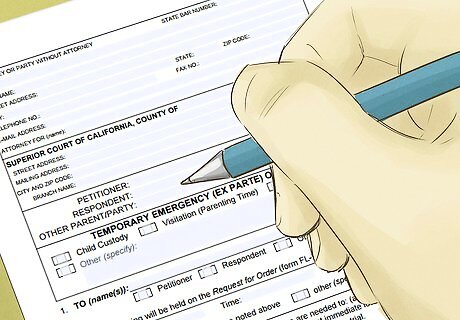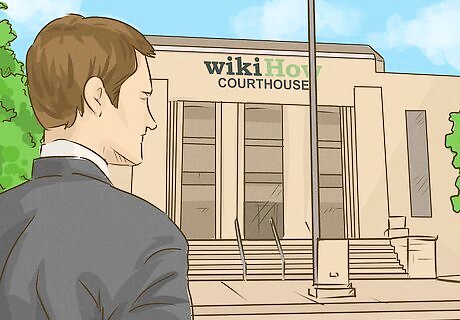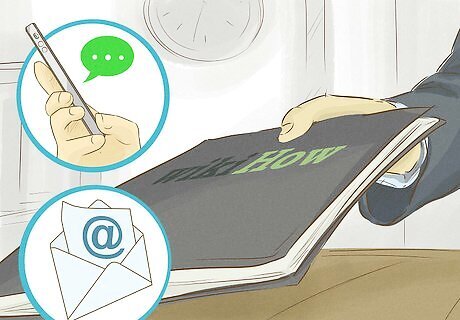
views
Preparing to File for Emergency Custody

Understand what emergency custody is. Generally, custody determinations take several months to decide. At the end of the process, the court will award legal and/or physical custody to a parent, or to both. Sometimes, however, emergencies require that a child be removed from a parent’s custody. What qualifies as a sufficient emergency is generally determined by your state’s statute. Typically, courts won’t remove a child unless the child is in “immediate danger” of harm or about to leave the state. “Immediate harm” often means recent or habitual domestic violence or sexual abuse. Immediate harm may also be a failure to supervise, as when a parent leaves a young child alone at home while (s)he went to the store. Understand that “emergency custody” is temporary. If you successfully petition the court for emergency custody, you have not been awarded permanent custody of the child. Because time is of the essence, a full, formal hearing will not be held. Sometimes, emergency custody will be granted without any hearing at all. Alternatively, a hearing will be held with only the parent petitioning for emergency custody in attendance. However, the court will hold a full formal hearing at a later date, with both parents present, before awarding permanent custody.

Check if you can seek emergency custody. State law limits who may petition the court for emergency custody. Often, you must be a parent, or someone who operates in loco parentis, in order to petition the court. “In loco parentis” means that although you are not a legal parent, you have acted as a parent and taken on the responsibilities of parenthood.

Gather evidence of the emergency. To be awarded emergency custody, you must typically show that the child faces “immediate harm.” Write down any conversations you have had, and collect emails or notes. You will want this information not only for your petition for emergency custody but later, should you seek full custody.

Meet with an attorney. If you have enough time, try to meet with an attorney. An attorney can be a stable sounding board during a confusing and turbulent time. If costs are a concern, some attorneys provide “unbundled services,” which means that they will provide limited services such as document preparation, legal advice, or coaching for a flat fee. Some places also offer counseling/legal help for free. If at any time you are confused about how to proceed, you should seek out a lawyer’s assistance. To find an experienced, local family lawyer, search your yellow pages or perform an internet search for “child custody attorney” and your city or county. Nevertheless, if you must file something that day do not wait to talk to a lawyer.
Completing the Forms

Find the correct court. Because you will file the motion in the county where your child currently lives, you must first locate that court. To find the appropriate courthouse, visit your state’s supreme court website. Type “Supreme Court” and then your state into a search engine. Alternately, you can visit this website and then click on your state. At your state’s Supreme Court website you should look for links to “Find Your Court” or “Court locations.”

Read the local rules. Motion practice is governed by state and local rules. You will have to abide by them, otherwise your motion may not be heard. Often the local rules are on the court’s website. You should download them and search for “emergency hearing” or “ex parte hearing.” The rules can be lengthy, so searching using CTRL+F will take you to the relevant part.

Get the forms. You must petition the court for emergency custody. Often, the court will have pre-printed “fill in the blank” forms for you to fill out. You can get the forms either from the superior court in the county where your child lives or on the internet. The forms go by different names depending on the court. Common names include “Temporary Emergency Court Order,” “Petition for Emergency Relief,” and “Motion and Affidavit for Emergency Ex Parte Order.” There are as many different names as there are courts. Visit the website for the courthouse where you will file the forms. The forms can often be downloaded from the court’s website. Nevertheless, you should still call and ask the clerk which forms you need to fill out. Although the clerk cannot provide legal advice, she should be able to tell you what forms you need in order to seek emergency custody. You may need to fill out multiple forms. Some courts may require that you already have a regular “motion for custody” pending. In these situations, you will have to file the other motion first. For this reason, be sure to tell the clerk what you have filed or haven’t filed. If the court clerk cannot help you, or you are confused as to what you need to fill out, seek the help of an attorney.

Read the instructions. Each form should come with instructions. Read the instructions first so that you will know what to fill out.

Fill out the forms. You will need to fill out these forms completely and accurately. If you download the form, you can type your text into the blue fields. Otherwise, use black or blue ink to neatly fill in the forms. Generally, you will need to provide the following information: your name and address, the other parent’s name and address, the other parent’s attorney’s name and address, as well as the reason why you are seeking the motion. Remember to only allege what you can prove with evidence. If you do not have proof that the child is in immediate danger of physical harm, then you should not make that claim in a motion. You could be held in contempt of court and ordered to pay court fees.

Get assistance. You may seek help with filling out your forms from a self-help center or the family law facilitator at the courthouse. You should call or stop in and ask if anyone is available.
Filing the Forms

Go to the courthouse. You must file the forms in the superior court for the county where your child currently lives. This is the same courthouse where you got the forms.

File the forms. Gather your forms and attach a copy of any written custody agreement you may have with the other parent. Also attach any other documentation that supports your contention that the child is in immediate harm. Read the form carefully to see if attaching information is allowed. Be prepared to pay any filing fees. Call ahead and ask how much the filing fee is and what acceptable methods of payment are. Ask when you should return to pick up the order. Sometimes, a judge or hearing officer will decide on emergency custody without needing to hold a hearing. In those situations, a written order granting emergency custody will be given to you. Alternately, the judge or hearing officer may schedule a hearing for that day or the following day. You will need to stop in and ask for the day and time so that you will know when to appear before the judge.

Pick up the order. If the court schedules a special hearing, then this information will be on the order that you pick up. You must make copies and serve the other parent. Make 2 copies for your records and 1 copy for the other parent.

Serve notice on the other parent. You must notify the other parent of the hearing that ultimately will be held. Different courts allow different methods of serving notice. Ask the court clerk what is acceptable. Generally, you should be able to serve notice using the sheriff/police. For a small fee, the sheriff/police will serve the other parent and fill out a form that shows service was made. Some courts may also allow you to mail notice. If the court allows, and it is easier to send by mail, then you will have to send the forms postage paid, return receipt requested.
Attending the Hearing

Prepare to argue your case. In order to get temporary custody, you may have to explain in court how the child faces "immediate harm." This hearing often will be “ex parte,” meaning that the other parent will not be present. This hearing is not a full trial, which you may have experienced when the court was initially deciding custody.

Bring evidence. If you have emails, letters, telephone messages, or video that you believe supports your case that your child is in immediate danger, then bring those to the hearing. Judges are unlikely to grant orders for emergency custody unless there is sufficient evidence of abuse. Use medical records or statements made by your child to support your argument.

Argue your case. In a calm, clear voice present the evidence to the judge and answer any questions the judge has. When you want to show the judge a document, state that you would like to admit the document into evidence. You should mark your documents “Exh. A, B, C” or “Exh. 1, 2, 3.” The judge will likely give a temporary order at the close of the hearing. This temporary order will be in effect until the final order is issued.




















Comments
0 comment